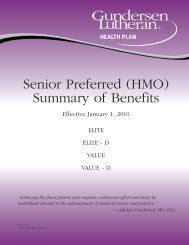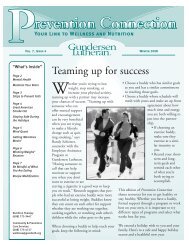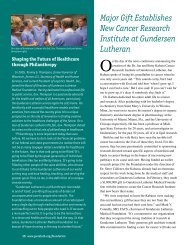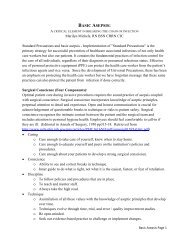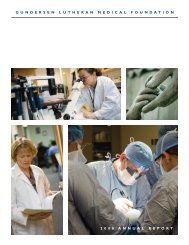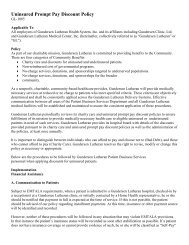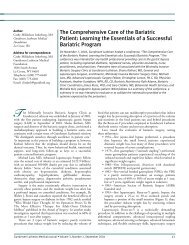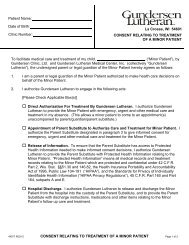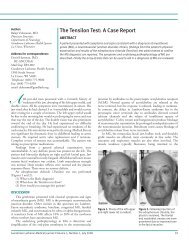ndersen er an - Gundersen Health System
ndersen er an - Gundersen Health System
ndersen er an - Gundersen Health System
Create successful ePaper yourself
Turn your PDF publications into a flip-book with our unique Google optimized e-Paper software.
Effect of Functional Ex<strong>er</strong>cise Training<br />
walk dist<strong>an</strong>ce in their subjects was virtually identical to that in<br />
the current study (7% v<strong>er</strong>sus 7.4%, respectively). Contrary to the<br />
current study, Whitehurst et al found signific<strong>an</strong>t improvements in<br />
hamstring flexibility (14%). They used the st<strong>an</strong>dard sit-<strong>an</strong>d-reach<br />
test, wh<strong>er</strong>eas we used the chair sit-<strong>an</strong>d-reach test. The increase in<br />
hamstring flexibility in their study was 1.6 inches, <strong>an</strong>d in our study<br />
the increase was 1.2 inches. Thus, even though the improvement in<br />
our group of subjects was not signific<strong>an</strong>t, the absolute improvement<br />
was comparable to that reported by Whitehurst et al.<br />
The goal of a functional fitness training program is to improve<br />
the ability to p<strong>er</strong>form ADLs. An improvement in the ability to<br />
p<strong>er</strong>form ADLs should make life easi<strong>er</strong> for individuals <strong>an</strong>d allow<br />
them to maintain their independence. We did not directly assess<br />
the psychological consequences of the increase in functional<br />
fitness; howev<strong>er</strong>, comments made by the subjects suggested that<br />
particip<strong>an</strong>ts exp<strong>er</strong>ienced carry-ov<strong>er</strong> benefit to common ev<strong>er</strong>yday<br />
tasks. Sev<strong>er</strong>al of the subjects commented that they found it easi<strong>er</strong><br />
to “reach for things,” had “bett<strong>er</strong> bal<strong>an</strong>ce,” <strong>an</strong>d 1 subject found<br />
it easi<strong>er</strong> to “look ov<strong>er</strong> [h<strong>er</strong>] should<strong>er</strong> while backing up [h<strong>er</strong>] car.”<br />
These comments are consistent with the findings of Whitehurst<br />
et al, 12 whose subjects had increased physical functioning <strong>an</strong>d<br />
vitality scores, as assessed by the Medical Outcomes Study 36-Item<br />
Short Form <strong>Health</strong> Survey (SF-36). Similar results w<strong>er</strong>e reported<br />
in chronically ill patients who w<strong>er</strong>e living in <strong>an</strong> assisted living<br />
facility. 20 Patients reported great<strong>er</strong> feelings of independence <strong>an</strong>d a<br />
great<strong>er</strong> quality of life that coincided with measured improvements<br />
in flexibility, grip strength, <strong>an</strong>d mobility.<br />
A factor that makes the current findings even more me<strong>an</strong>ingful<br />
is that subjects in the current study w<strong>er</strong>e already regular ex<strong>er</strong>cis<strong>er</strong>s.<br />
All of the subjects w<strong>er</strong>e doing 30 to 45 minutes of a<strong>er</strong>obic ex<strong>er</strong>cise<br />
3 days p<strong>er</strong> week, as well as 10 to 15 minutes of resist<strong>an</strong>ce training.<br />
Based on published age-specific <strong>an</strong>d sex-specific norms for the FFT, 21<br />
the subjects in the current study exceeded the 80th p<strong>er</strong>centile for<br />
each item. Comparisons between subjects in oth<strong>er</strong> studies, such as<br />
those of Whitehurst et al, 12 provide furth<strong>er</strong> evidence of the fitness<br />
of our subjects. Subjects in the 2 studies w<strong>er</strong>e of similar age, yet<br />
subjects in the current study p<strong>er</strong>formed the pretesting 8-foot up<strong>an</strong>d-go<br />
test in 5.50 seconds, v<strong>er</strong>sus 7.92 seconds for their subjects.<br />
Initial 6-minute walk dist<strong>an</strong>ces w<strong>er</strong>e also v<strong>er</strong>y diff<strong>er</strong>ent, with our<br />
subjects initially walking 618 yards, compared with 365 yards for<br />
their subjects.<br />
A possible limitation of <strong>an</strong>y study investigating functional<br />
ex<strong>er</strong>cises is that the training ex<strong>er</strong>cises closely resemble the testing<br />
protocol. For example, the warm-up sequence included st<strong>an</strong>ding<br />
hamstring stretches for flexibility. One of the tests on the FFT, the<br />
chair sit-<strong>an</strong>d-reach test, is designed to assess hamstring <strong>an</strong>d low<br />
back flexibility. Thus, it c<strong>an</strong> be seen that the training <strong>an</strong>d testing<br />
movements w<strong>er</strong>e similar, but not identical. The key point is that<br />
conc<strong>er</strong>ns about specificity of training/testing protocols in this type<br />
of study should not be a major issue. If the testing batt<strong>er</strong>y is valid,<br />
Table 2. Pretest <strong>an</strong>d Posttest FFT Scores of Control <strong>an</strong>d Exp<strong>er</strong>imental Groups<br />
Variable<br />
Group Pretesting Posttesting Ch<strong>an</strong>ge<br />
Chair sit-to-st<strong>an</strong>d, me<strong>an</strong> (SD), repetitions<br />
Control<br />
Exp<strong>er</strong>imental<br />
Bicep curls, me<strong>an</strong> (SD), repetitions<br />
Control<br />
Exp<strong>er</strong>imental<br />
6-minute walk, me<strong>an</strong> (SD), yds<br />
Control<br />
Exp<strong>er</strong>imental<br />
15.0 (3.7)<br />
13.8 (3.1)<br />
15.1 (2.7)<br />
13.8 (2.6)<br />
641 (79.1)<br />
618 (62.4)<br />
14.9 (3.4)<br />
-.1<br />
15.6 (2.6) a +1.8<br />
14.6 (3.4)<br />
-.5<br />
15.7 (3.1) a +1.9<br />
+2<br />
643 (83.9)<br />
+43<br />
661 (67.1) a<br />
Chair sit-<strong>an</strong>d-reach, me<strong>an</strong> (SD), in<br />
Control<br />
Exp<strong>er</strong>imental<br />
-4.8 (3.5)<br />
-5.3 (4.8)<br />
-4.4 (3.9)<br />
-4.1 (3.9)<br />
-.04<br />
-.8<br />
Back scratch, me<strong>an</strong> (SD), in<br />
Control<br />
Exp<strong>er</strong>imental<br />
8-foot up-<strong>an</strong>d-go, me<strong>an</strong> (SD), sec<br />
Control<br />
Exp<strong>er</strong>imental<br />
Abbreviations: FFT Functional Fitness Test; SD, st<strong>an</strong>dard deviation.<br />
a<br />
Signific<strong>an</strong>tly diff<strong>er</strong>ent from the control group (P < .05).<br />
-2.6 (3.4)<br />
-3.7 (5.8)<br />
5.1 (.53)<br />
5.5 (.77)<br />
-2.7 (3.6)<br />
-.1<br />
-2.1 (4.9) a +1.6<br />
5.1 (.75)<br />
0<br />
4.8 (.50) a -.7<br />
Gu<strong>nd<strong>er</strong>sen</strong> Luth<strong>er</strong><strong>an</strong> Medical Journal • Volume 5, Numb<strong>er</strong> 1, July 2008 7




